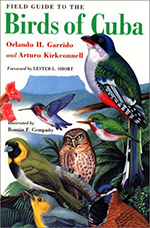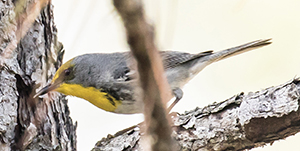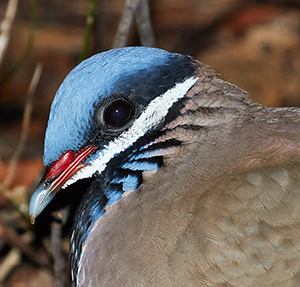South America
Natural Adventures
Nature travel, wildlife and birding tours, with a
side of culture, to Peru, Colombia, Guyana, Ecuador & Galapagos,
Costa Rica, Honduras,
Panama, Belize, Guatemela, Cuba and more
CUBA
Welcome to Cuba,
the most fascinating island in the Americas

Our next tour to Cuba begins March 31 2020
ONLY 4 SPACES LEFT
For our 2020 Nature Travel Specialists
birding tour of Cuba we have slightly revised itinerary compared to
our first Cuba trip. We’ve removed Camaguay, and our first day
is just flying into Havana and overnighting there. This allows us
to travel to Viñales at a more relaxed rate and look
for Giant Kingbird along the way. We’re also using more particulares
and paladares, small private accommodation places and restaurants
operated by local Cubans (most hotels and restaurants used by international
visitors and many Cubans are Government-run). These are always wonderful
opportunities to directly interact with the Cubans, and also to reward
them for their business acumen. Cuba is the largest island in the
Caribbean and supports an incredible variety of habitats from interior
tropical forests, montane forests, to extensive wetlands and mangroves.
Lying only 90 miles from Miami, Cuba boasts 372 species of birds,
about 23 of them endemic, with several more that we’ll see likely
future splits resulting in endemicity for the Cuban form. The date
and locations  visited
are designed to give us the maximum opportunities to see and learn
about Cuba’s birds while sharing knowledge and skills with the
Cuban people during our stay.
visited
are designed to give us the maximum opportunities to see and learn
about Cuba’s birds while sharing knowledge and skills with the
Cuban people during our stay.
Organizing our exclusive tour
is ornithologist, educator, and extraordinary birding guide Arturo
Kirkconnell. Arturo is the bird curator at the National Museum of Natural History of Cuba.
His curriculum vitae includes 77 scientific papers and he is the author
of two books: A Field Guide to the Birds of Cuba (available in both
English and Spanish with more information in the Spanish edition),
and A Birdwatchers’ Guide to Cuba, Jamaica, Hispaniola, Puerto
Rico and the Caymans. At present he is working on another project,
The Birds of Cuba, that will be published by the British Ornithologists
Union’s BOU Checklist Series. Arturo has been leading birding
tours in his native Cuba since 1988 and is the most sought after guide
in the country. Our cultural Guide will have a wealth of knowledge
about Cuban history, politics and general life, much of it discussed
from his own life’s experiences. And just to ice the cake, he’s
also an accomplished birder. Once again our overall group leader is
Andrew Haffenden, making his sixteenth trip to Cuba.
the bird curator at the National Museum of Natural History of Cuba.
His curriculum vitae includes 77 scientific papers and he is the author
of two books: A Field Guide to the Birds of Cuba (available in both
English and Spanish with more information in the Spanish edition),
and A Birdwatchers’ Guide to Cuba, Jamaica, Hispaniola, Puerto
Rico and the Caymans. At present he is working on another project,
The Birds of Cuba, that will be published by the British Ornithologists
Union’s BOU Checklist Series. Arturo has been leading birding
tours in his native Cuba since 1988 and is the most sought after guide
in the country. Our cultural Guide will have a wealth of knowledge
about Cuban history, politics and general life, much of it discussed
from his own life’s experiences. And just to ice the cake, he’s
also an accomplished birder. Once again our overall group leader is
Andrew Haffenden, making his sixteenth trip to Cuba.
As an OFAC authorized Support
for the Cuban People tour we continuously engage participants with
the warm, friendly people of Cuba in addition to our strong emphasis
on birds, nature and culture. You will experience Cuba in a most personal
way, through the eyes of the Cubans. We meet with local biologists
and naturalists as we visit reserves and other nature areas where
Cuban endemic species as well as specialty bird species are located.
We also visit local farmers, art galleries and have other cultural
opportunities to exchange our experiences and ideas of the US so as
we learn about Cuba, the Cubans learn about us. Most restaurants feature
musicians, as the arts are considered a real career in Cuba so are
fostered and supported. We often get the chance to discuss the music
with them, sharing our different experiences and perspectives. Our
meetings and interactions with all the people we meet along the way,
from Professors to farmers to everyday Cubans serve to promote two-way
understanding and insight to Cubans from people who live outside the
Cuban borders and to bring skills and knowledge to local Cubans to
improve their life within Cuba. The tour begins and ends in Havana.
ITINERARY

Day 0 – Home City/Havana
Fly to Havana today where you are met and taken to our casa particulare
in old town Havana. Today is free due to the various times different
airlines arrive into Havana. Tonight we'll have a welcome dinner at
one of Havana's best cuban restaurants.
Day 1 - Havana/Viñales
Valley
After breakfast we leave for the Viñales region in Pinar del
Rio province, about three and a half hours away. We'll bird along
the way, especially for the endemic Giant Kingbird. The Viñales
valley is an area rich in birdlife and with some of the best landscape
in Cuba. The prime landscape of feature of the region are the mogotes,
outcrops limestone karst forming hills ranging from about 50ft to
1000ft. They are usually steep sided and often domed, due to a hard,
weathered limestone cap and softer limestone sides. Caves are found
throughout the mogotes, including shallow open ones where one can
see stalactites while driving the roads. We’ll spend two nights
here to have time to enjoy the area, and get our bird list off to
a good start with endemic Cuban Blackbird.
Day 2 –Viñales
Valley
 We’ll record many of the birds today that will become familiar
to us over our Cuba Journey including Cuban Trogon, Cuban Tody, Cuban
Bullfinch, Cuban Green Woodpecker and the stunning Red-legged Thrush,
which like the Western Spindalis is particularly colorful in Cuba.
Cuban Grassquit and Cuban Solitaire are most likely to be found in
the Viñales area, and we’ll make a special effort for
these. The Solitaire, a rather drab bird, is usually not difficult
We’ll record many of the birds today that will become familiar
to us over our Cuba Journey including Cuban Trogon, Cuban Tody, Cuban
Bullfinch, Cuban Green Woodpecker and the stunning Red-legged Thrush,
which like the Western Spindalis is particularly colorful in Cuba.
Cuban Grassquit and Cuban Solitaire are most likely to be found in
the Viñales area, and we’ll make a special effort for
these. The Solitaire, a rather drab bird, is usually not difficult
 to
find by call, but much harder to see even when close. Its call sounds
like what you might get if you crossed a Yellow-breasted Chat with
a Wood Thrush, and is quite ventriloquial. As it prefers densely foliaged
trees and stays still, it can be a frustrating beast indeed. But we
have plenty of time, and should be successful. We’ll be going
to a number of locations with opportunities, but especially Cueva
de los Portales adjacent to Parque Nacional La Guira. This large cave
in a mogote is both scenic and historic; Che Guevara used it as the
headquarters of his army during the Cuban Missile Crisis, and it is
now Cueva de los Portales adjacent to Parque Nacional La Guira. This
large cave in a mogote is both scenic and historic; Che Guevara used
it as the headquarters of his army during the Cuban Missile Crisis,
and it is now national monument. Among the pine trees we’ll
look for endemic Yellow-headed Warbler and regional endemic Olive-capped
Warbler.
to
find by call, but much harder to see even when close. Its call sounds
like what you might get if you crossed a Yellow-breasted Chat with
a Wood Thrush, and is quite ventriloquial. As it prefers densely foliaged
trees and stays still, it can be a frustrating beast indeed. But we
have plenty of time, and should be successful. We’ll be going
to a number of locations with opportunities, but especially Cueva
de los Portales adjacent to Parque Nacional La Guira. This large cave
in a mogote is both scenic and historic; Che Guevara used it as the
headquarters of his army during the Cuban Missile Crisis, and it is
now Cueva de los Portales adjacent to Parque Nacional La Guira. This
large cave in a mogote is both scenic and historic; Che Guevara used
it as the headquarters of his army during the Cuban Missile Crisis,
and it is now national monument. Among the pine trees we’ll
look for endemic Yellow-headed Warbler and regional endemic Olive-capped
Warbler.
Day 3 – Viñales
Valley/Playa Larga
We depart for Playa Larga this morning – our departure will
depend on whether we need to find and record any birds we missed or
need further time with. We’ll along the way make a stop at a
lake that is good for ducks, Least Grebes, kingfishers and other waterbirds.
We’ll als o
make other stops as needed for birding along the way, especially at
some agricultural ponds for Snail Kite,
o
make other stops as needed for birding along the way, especially at
some agricultural ponds for Snail Kite, .jpg) herons
and egrets and the likely to become endemic Eastern Meadowlark. We
should arrive mid-afternoon in Playa Larga, located at the norther
tip of Bahía de Cochinos, better known to most in the US as
the famous or infamous, depending on your outlook, Bay of Pigs. Immediately
adjacent is Zapata Swamp, the largest and best preserved and protected
swamp in the entire Antilles, and is home to many endemic plants,
birds and other animals, including the extremely endangered Cuban
Crocodile. Tonight and another nights we’ll check a couple of
spots for the nearly mythical Stygian Owl, and we’ll also look
for other night birds such as the former Greater Antillean Nightjar,
now split resulting in another endemic, Cuban Nightjar.
herons
and egrets and the likely to become endemic Eastern Meadowlark. We
should arrive mid-afternoon in Playa Larga, located at the norther
tip of Bahía de Cochinos, better known to most in the US as
the famous or infamous, depending on your outlook, Bay of Pigs. Immediately
adjacent is Zapata Swamp, the largest and best preserved and protected
swamp in the entire Antilles, and is home to many endemic plants,
birds and other animals, including the extremely endangered Cuban
Crocodile. Tonight and another nights we’ll check a couple of
spots for the nearly mythical Stygian Owl, and we’ll also look
for other night birds such as the former Greater Antillean Nightjar,
now split resulting in another endemic, Cuban Nightjar.
Day 4 – Playa Larga
The Zapata Swamp is rich in birds – it supports 20 of Cuba’s
23 or so endemics - so once again endemics will be high on our list.
The southern race of Zapata Sparrow is usually reliable here, and
though patience is required for this shy species, and Zapata Wren
is also usually encountered here. While looking for these we also
listen for the rare Cuban Sandhill Crane. Gundlach’s Hawk breeds
here, and both endemic Red-shouldered and near endemic Tawny-shouldered
Blackbirds (the island of Hispaniola is its other location) should
be seen here. The large Great Lizard-cuckoo is common, and Cuban Oriole
is often seen in flowering shrubs and trees, including in built-up
argood for Grey-fronted Quail-dove and White-crowned Pigeon. As we
have a number of areas within easy reach, and birds can be hardereas.
There’s an area nearby that’s usually to see in the thick
swamp and forest we’ve devoted two full days to Zapata, giving
us both better chances of finding everything, and time for both careful study and getting important photographs for the records.
One day we’ll visit the home of a local couple, whose yard attracts
both Bee Hummingbirds and Cuban Emeralds due to the planting of preferred
food species. Those interested can learn more about the Bay of Pigs
invasion at a small museum in Playa Giron.
both careful study and getting important photographs for the records.
One day we’ll visit the home of a local couple, whose yard attracts
both Bee Hummingbirds and Cuban Emeralds due to the planting of preferred
food species. Those interested can learn more about the Bay of Pigs
invasion at a small museum in Playa Giron.
 Day
5 – Playa Larga area
Day
5 – Playa Larga area
We continue to find and record the birds and natural world of Zapata,
visiting a large saline area where we find hundreds of American Flamingo,
Roseate Spoonbill, American Avocet, Black-necked Stilt, Red Knot during
migration, Gull-billed Terns, Cuban Yellow Warbler, and many more.
We take river journey in a small boat to search for birds in a fresh
to brackish water environment, and may see the endangered Cuban Crocodile.
One morning a local guide takes us to a protected area with many endemics
– Cuban Trogon, Tody, Oriole, Screech Owl, Pewee, Vireo, Parakeet
and Parrot can all be found here, as can the endemics Bare-legged
Owl, Blue-headed and Gray-fronted Quail-doves. By walking around the
village we can interact and learn more about our Cuban neighbors,
as they do of us.
continue
with itinerary >>>

